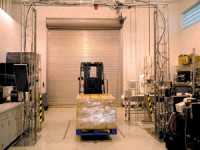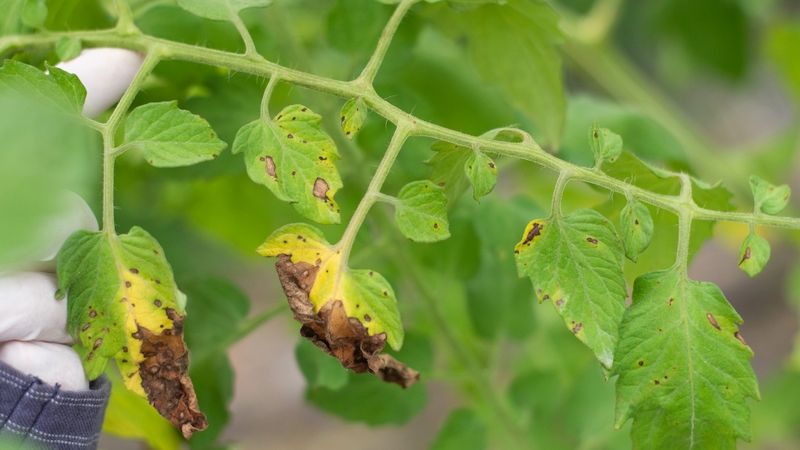Promoting Smart Vegetable Packaging


A produce pallet fitted with radio frequency identification (RFID)
tags passes through the RFID portal at the University of Florida
Center for Food Distribution & Retailing RFID laboratory. RFID is a
system that transmits the identity of an object using radio waves.
The product’s packaging is a vital chaperone for the vegetable for numerous reasons, as it:
• Allows rapid product cooling and facilitates subsequent temperature management;
• Protects the commodity from injury, environmental extremes, and from potential sources of contamination;
• Communicates information about the product to buyers and regulators alike;
• Lures potential customers with its attractive and functional design;
• Promotes the product’s virtues to potential buyers; and
• Facilitates the movement of the product through marketing channels.
Such packaging must also be economical and maintain strength even under high relative humidity conditions. Some packages are also designed with semipermeable films that create a modified atmosphere (MA) to help maintain freshness. The cost of these packages is significant and may represent anywhere from 15% to 90% of the cost of the product itself.
While most consumers are concerned about how well it protects food against spoilage and prevents flavor loss, there is expanding interest in convenience, environmental concerns with production and disposal, food safety concerns, and new packaging technologies. This concern is influencing important changes in produce packaging.
Convenience
Consumers are increasingly turning to food items that are healthy, fast, and easy to consume. With increased “dashboard dining” and the public’s desire to consume food without a spoon, the use of vegetable packaging that is convenient to use is increasing. Examples include single-serve or recloseable packaging and ready-to-serve packages, some with self-venting film overwraps that allow microwave cooking.
With environmental issues such as those related to global warming making headlines, “environment-friendly” (also called “green,” “Earth-friendly,” or “sustainable”) packaging has received increased consumer attention. Such packages are often made from renewable resources and/or are biodegradable.
One example is a biopolymer called polylactic acid (PLA) made from plant materials such as corn starch, sugarcane, and switchgrass. PLA has many of the same properties (texture, toughness, clarity, etc.) as conventional plastics. It can be heat-sealed at lower temperatures, and it can be formed into rigid thermoformed structures, bags, films, labels, and bottles. PLA also can be composted, biodegrading into water, carbon dioxide, and organic matter. However, it is a bit more expensive than conventional materials.
More In Biodegradables
Other biodegradable and home-compostable materials include palm fiber, used to make produce trays, and wood-derived packages that include wooden crates, fiberboard containers, and cellulose films. Most perishables are still packed in corrugated fiberboard boxes.
Retailers such as Wal-Mart, ASDA, Sainsbury, Tesco, and Marks & Spencer have picked up on customer interest in environment-friendly packaging with programs to increase the use of such packaging and to reduce the overall amount of packaging going to landfills. Retailers are working to move away from conventional plastics and instead purchase fresh produce packaged in compostable polymers such as PLA. Instead of packaged produce, some retailers are moving toward greater use of bulk bins to reduce the amount of packaging received.
Growers’ attitudes to these changes appear mixed. An overall reduction in packaging could reduce costs, which is favorable as long as sufficient packaging is maintained to adequately protect the product. Increased use of plant-derived packaging could also open new markets (e.g., PLA production) for that portion of some crop (e.g., potatoes) not suitable for the fresh market.
Furthermore, some growers use ecologically friendly packaging as a marketing tool to boost sales to environmentally conscious buyers. On the other hand, growers are also concerned that they will be required to bear the costs for changing over to these new and often more expensive packaging materials.
“Smart” Packages
Smart packages are those that sense information about the product and/or adjust the package’s properties in response to commodity or environmental changes. For example, instead of containers that simply restrict gas exchange to create a MA within the packages, smart packages change their oxygen and carbon dioxide transmission rates according to surrounding temperature. In this way, products are allowed to “breathe” even when product respiration increases following transfer to warmer conditions.
Sensing technology based on physical or chemical properties of the food or food contaminants can be built into packages and used to monitor product quality, shelflife, or safety. For example, RediRipe ripeness-sensing stickers measure the ethylene production inside the package to determine ripeness, turning from red to yellow as the product ripens.
Other package sensors measure time-temperature accumulation to better determine “best by” dates that account for periods when the product may be held at non-optimal temperatures. Still other sensors developed for the seafood industry detect byproducts from spoilage organisms; similar technology could be adapted to the produce industry. With highly publicized outbreaks of foodborne illness being tied to fresh produce, such sensors could improve the public’s confidence in the fresh produce industry.
The use of Radio Frequency Identification (RFID) tags is anticipated to increase for both conventional and smart packages. These tags allow information such as product variety, production location and history, harvest and packing date/time, postharvest treatments, etc. to be associated with individual packages. With integration of various sensors into the RFID tags themselves, information collected by the smart packages can be automatically collected and downloaded as produce pallets pass through shipping and receiving portals. Operators would then be alerted whenever RFID/sensor data deviated outside predetermined critical values.
Packaging will continue to become more convenient, environmentally sustainable, and “smart.” The question remains for each commodity and customer base: How will these features be balanced with individual commodity requirements and how will the added value offset anticipated increased costs?








